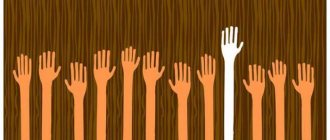What it is
Stereotyping began to be considered in the 20s of the twentieth century. Stereotypical thinking is characterized as a narrow paradigm that is stored in the head to save effort required when perceiving certain complex situations and phenomena. Researchers have identified two reasons for the formation of such patterns: the economy of the mind and the desire to preserve the values of a particular group.
This kind of standardization has the following characteristic features:
- sustainability;
- selectivity;
- emotional basis.
Simply put, people use stereotypes so as not to bother themselves with additional thinking. When they manage to find confirmation of their thoughts in the behavior of others, they become even more convinced of the truth of their own or collective conclusions. Stereotyping is a certain replacement for mental activity.
To one degree or another, each of us is subject to such beliefs, with the only difference being that some truly firmly believe in such “postulates,” while others are able to question them.
Various kinds of prejudices influence a person’s worldview, his behavior and encourage a distorted vision of reality. Patterns can be imposed by society or arise based on personal observations. The former are more harmful, since they impose an incorrect way of thinking on the individual and do not allow him to analyze the situation objectively and independently.
But still, without stereotyping, society could not exist. It allows consciousness to build important patterns:
- water may wet;
- it's cold in winter;
- the flame burns.
Knowing this, we do not need to verify our assumptions in practice every time. However, there are stereotypes that affect a person’s consciousness and subconscious, preventing him from living.
You should learn to distinguish prejudices from the real state of affairs. The same concept can be dictated by the internal motivations of an individual or imposed on it by society. In the second case, the individual feels a conflict between his interests and what public opinion requires of him. The desire to follow stereotypes imposed from the outside distorts the vision of the real.
Often we judge others not by their actions, but by what others say about them. For example, a person who occasionally attends church may assume all the characteristics of a real Christian, although in fact this is not the case at all.
How to get rid of the problem of stereotypical thinking?
Life is bright and interesting
We, people, are endowed with consciousness and let's use it, and not turn our lives into a mechanical, automated process.
How to learn to enjoy life?
Breathing brings you back to a unique moment in life.
Testicular breathing. If there is no vitality Kapalbhati. Cleansing breathing practice
Observation and control of breathing brings you back to the conscious process of life and destroys stereotypical perceptions.
After all, stereotypes arise when you fall out of the present moment and are carried away by the current of your own thoughts. The effect of breathing is to bring yourself back.
As soon as you catch yourself again falling into the trap of stereotypical thinking and the perception that you are constantly thinking about something, doing everything on autopilot, that you haven’t noticed how an hour has passed - stop for a few moments, take a few slow breaths and exhalations, feel the weight of your body, your feet touching the floor.
With each breath, feel the air entering your body through the tip of your nose. Each exhale the air comes out, it is already a little warmer. With each inhalation, the body rises slightly, expands, and with each exhalation, it lowers.
This brings you back to the present moment.
The effect of meditation in just 15 minutes a day Why should you learn meditation?
Be curious and wonder. Everything.
The next step to stop stereotypes from ruling your life is to try something you haven’t tried before.
Take a different route to pick up your child, buy groceries at a store you don’t usually go to, and buy something unusual, try a new taste. Have dinner on the floor with a plate on your lap.
Before entering the apartment, stop, breathe, listen to the sounds around you: wind, birds, voices, cars, rustling leaves, cats, dogs, raindrops, listen to everything. Breathe deeply, feel the air temperature.
Be curious and you will feel the effect.
Break perception stereotypes with the help of nature. Watch her, touch her.
What nature created and what man created
Go to the park, look at a tree, touch it, feel the texture, break off a piece. Think about how old this tree might be, look at its shape, maybe it's unusual, what could cause this.
Maybe when it was still very small, someone stepped on it or broke it, but, despite everything, it continued to grow.
Take a stone in your hands, feel its temperature, what it is like: smooth, rough. Think about its history. How old could he be? 100, maybe 1000, maybe millions of years. Maybe a dinosaur's foot walked on it when it was part of a rock or a block of stone.
Break habitual thinking, destroy stereotypes and a simplified view of things. Every stone is a miracle, a story, a beauty.
There is no right and wrong. Reality is neutral
Stereotyping effect
This is the process of the emergence of a stable belief or image, when, based on one’s own or social practice, a person fixes in the mind some picture of the world.
When encountering a previously unknown phenomenon, the brain begins to analyze the situation and look for something familiar in it. The resulting settings compare a new object with a similar group, which allows you to quickly classify data and, if necessary, retrieve it from memory.
What is a stereotype?
A stereotype is an assessment of an object or phenomenon that has been established for a long time, prevailing in the public consciousness and forming a biased attitude towards this object or phenomenon.
The tendency to create stereotypes and believe them is common to all people. It was formed in us evolutionarily, since the brain has always sought to save energy spent on mental activity. He simplifies the picture of the world, tries to make unfamiliar things understandable, explaining them with simple and familiar phenomena.
Stereotypes are a form of accumulated experience, ready-made thinking patterns that allow you to quickly draw conclusions and make decisions. Some of them are inherent in instincts at the genetic level (for example, the belief that you need to be wary of people with certain appearance features). But the main part of stereotypes is laid down during upbringing and in the process of communication.
Most existing stereotypes are irrelevant or meaningless. Instead of protecting us from potential dangers and aggressors, they noticeably distort reality, giving it a negative connotation.
Features of stereotypical thinking
Thinking in patterns means not logically justifying information when receiving different experiences, but comparing what is happening with what has already been deposited in the mind. Thus, the world becomes safer for the mind, since it is subject to a certain order.
Psychologist Daria Milai
Make an appointment
Stereotypes can be formed from childhood. These are beliefs, values, norms, reactions, assessments that a child absorbs from adults. When the mind is subject to stereotyping, it interferes with the full and comprehensive development of the personality. Independence and objectivity of views disappear.
Patterned behavior is most often encouraged by society. In other words, when a person lives like everyone else, he does not strive to show individuality - it is so simple, calm and comfortable.
Prejudices allow you to act “automatically” and prevent you from looking at the situation from a different angle. Stereotypical processes presuppose the presence of an attitude: to act only this way and not otherwise. Someone whose behavior is determined by stable patterns has a hard time accepting new things, treating them with distrust and even aggression, since unknown information disrupts internal balance and comfort. He has a specific, proven model of action, and he follows it.
Pros and cons of stereotypical thinking
People who are accustomed to thinking in stereotypes can live a full life, even receiving certain benefits from this feature. The main advantages of stereotypical thinking include :
- quick decision making;
- less mental fatigue when analyzing information;
- joining a certain social group.
At the same time, the tendency to think in stereotypes imposes certain limitations. Its main disadvantages include :
- wrong decisions and wrong actions;
- excessive gullibility, inability to think critically;
- inability to analyze and draw conclusions independently;
- patterned thinking hinders development.
Stereotyped thinking has more disadvantages, so it is necessary to combat it by developing the ability to think critically and objectively analyze incoming information.
Advantages and disadvantages
Pros:
- automatic thinking, which helps in everyday matters;
- the ability to group objects and phenomena, facilitating the thought process;
- “pass” to one or another group of society.
Minuses:
- lack of freedom of thought and action;
- development slowdown;
- patterning prevents you from accepting new things and learning;
- the occurrence of errors when the situation is not similar to the usual one, and the individual cannot move away from a stable image;
- gullibility, inability to conduct a critical analysis.
Types of stereotypes in psychology
- Patterns of perception.
- Ethnic.
- Gender.
- Age.
- Social.
- Attitudes in communication.
- Heterostereotypes.
Stereotyping can be superficial or deep. In the first case, we are talking about beliefs formed by an unfounded assessment of various external characteristics: the emotionality of Italians, the perfectionism of Germans, the laziness of Russians. As a rule, they change due to the development of mankind.
A deeper version of patterning involves patterns of behavior and thinking that are transmitted between people over years or even centuries. For example, many consider the balalaika, matryoshka, vodka and bears to be essential elements of the Russian tradition.
Face-to-face consultation
What are the features and advantages of face-to-face consultation?
Find out more
Skype consultation
What are the features and benefits of Skype consultations?
Find out more
They are formed under the influence of certain historical events.
Examples of popular stereotypes in society:
- it is impossible to achieve success in a career without “pull”;
- a man never cries;
- children are dependent, helpless;
- Jews are a mercantile people;
- a woman on a ship is a bad omen;
- the higher the price, the better the quality of the product;
- You cannot live with dignity without higher education.
It is believed that the girl is weak, passive and frivolous. She is often perceived as an “appendage” of a man. To compensate for her natural inferiority, she must strive to look more beautiful than everyone else and cunningly capture a rich and attractive husband. Then you need to give birth to children and live off your patron. A lady does not need to be strong or occupy high positions. Otherwise she will feel unhappy.
Representatives of the male sex have also acquired their own stereotypes. There is a common belief that a priori are the main ones in a relationship. Another illusion is that every guy loves football, is obsessed with sex, and they are also terrible womanizers. “All men cheat!” – you’ve probably heard this statement more than once.
Parents are convinced that children should meet their expectations. All teenagers are considered difficult, and their dreams and plans are not taken seriously, attributing their impulses and ideas to “youthful maximalism.” Middle-aged people are in a state of crisis. Old people are sick and unhappy. Young people think only about entertainment and do not respect their elders. Unemployed people are losers, and happiness is impossible without a huge bank account. Not believing in God is madness. Society is replete with stereotypes about what is “good” and what is “bad”, what a “normal” person should be, how and where one can obtain the “correct” knowledge. However, most of them are associated with fears, complexes, weakening of analytical thinking and are not supported by logic.
The role of stereotypes in human life
Social stereotypes play a huge role in everyday communication due to a number of their features.
7 pages, 3188 words
1. Perception of a person by a person in communication
1. Perception of a person by a person in communication The perception of a person by a person begins with an assessment of the face. All people have long recognized their ethnicity, gender, age, mood, and sometimes character by their faces. Since ancient times, the Japanese have been able to determine the intentions and even the fate of a person by their faces. This is also related to their desire to hide their faces, which is why the Japanese, as a rule, have a calm, serene expression...
1. They seem to predetermine the perception of a specific life situation, since we comprehend the social reality around us not directly, but indirectly, through the prism of social stereotypes that have developed in our minds or learned from the outside.
Indicative in this regard is an experiment conducted by the famous psychologist A.A. Bodalev. During the experiment, a group of adult subjects were shown several photographs. Participants in the experiment, who saw each photo for five seconds, had to recreate the image of the person they had just seen. The display of the photograph was preceded by an installation on a certain stereotype - a characteristic of the people depicted in it. For example, they said “Now you will see a portrait of a criminal” or “... a portrait of a hero”, etc. 35.3% of the subjects were influenced by the proposed attitude, 54% did not experience any noticeable influence, and 10.7% actively resisted the proposed stereotype.
Here are the portrait characteristics given to the young man depicted in the photograph: “This beast wants to understand Something. Looks smart and without interruption. Standard gangster chin, bags under the eyes, massive figure, aging, thrown forward (set to the “criminal” stereotype).
“A young man, 25-30 years old. The face is strong-willed, courageous, with etching features. The look is very expressive. Hair is disheveled and unshaven; The collar of the shirt is unbuttoned. Apparently, this is the hero of such and such a battle, although he is not wearing a military uniform (dressed in a checkered shirt)” (the setting is “hero”).
7 pages, 3434 words
The influence of gender stereotypes on communication and interaction of people
... In this test you can see that the influence of gender stereotypes on communication and interaction of people is great. Any person can easily determine the gender of a character in a comic book... there is a debate among scientists in various areas of gender psychology, as well as in social psychology. According to social psychologists, the explanation for many gender differences...
The polarity of judgments about the same person is explained by the fact that the photograph itself provides little information and the participants in the experiment are forced to reproduce the signs of the proposed stereotype.
2. The social stereotype “saves thinking” by depersonalizing and formalizing communication. Identification with an already known model predetermines a standard reaction, allows you to use an already familiar model of role behavior, and act as if automatically. It is for this reason that official communication with strangers and unfamiliar people occurs more according to a stereotype.
So, for example, every more or less experienced seller develops a set of stereotypes of buyers such as “attentive” - “absent-minded”; "picky"; “polite” - “rude”, etc., which allows the seller, without hesitation, to behave accordingly.
3. Each social stereotype includes a description, prescription and assessment of the situation, although in different proportions, which fully corresponds to the components of the human “I”.
4. Stereotypes are very persistent and are often passed down from generation to generation, even if they are far from reality. This includes, for example, the common belief of many in a good king (president), who will solve all problems at once and make life better.
5. The further we are from a social object, the more we are influenced by collective experience.
What are stereotypical attitudes?
Below I will describe in more detail the most common models that exist in the social paradigm.
Gender stereotyping: women and men
- A girl is an emotional, unreasonable, weak creature. Her mission is to give birth, run the house and take care of the man.
- Every girl needs to learn how to apply makeup, dress beautifully and behave properly around boys, in order to later find someone who will fully provide for her and her children.
- Strong ladies are usually loners.
- A single mother is an unhappy, abandoned victim.
- A business woman has no time for family values.
- A man should be a little more handsome than a monkey. His task is to earn money to provide financially for the woman. They don't need love, they only want sex.
- Representatives of the stronger sex should not express their feelings or perform “feminine” duties: cooking, washing.
- A real man must work, support his family, and drive a car.
The above examples of common stereotypes show that many people do not see an individual personality behind a particular person. Due to the huge number of cliches that we receive in childhood, problems arise in relationships: partners are simply not able to hear and understand the position of the other half.
During my consultation, you will be able to destroy many illusions regarding energy. You will find your resource state, realize your own importance and move to a new level of development of your individuality.
Children
They are obliged:
- Listen to adults in everything.
- Fulfill the unrealized plans of parents.
- Get good grades in school.
- Go to university in agreement with mom and dad.
- Don't be smart.
At the same time, it is believed that all kids are ugly, they cannot be trusted with anything, they break and spoil things. The younger generation is dissolute, stupid, young people are not aware of what they are doing.
Happiness
The essential elements of a happy life are:
- Money.
- A dream come true.
- High social status.
But in fact, each person has his own system of coordinates, values and desires. You have the right to decide for yourself what is important to you.
"Correct"
- Only in elite universities can you get a good education.
- “Normal” people get jobs regardless of their desires. You don't have to like the activity.
- You need to live in your homeland, and not move to another country.
- It is necessary to follow trends.
- You need to dress in expensive stores.
- You cannot live without faith in God.
- The opinion of an individual must correspond to the position of the majority.
What are the stereotypes?
Please note, we are talking about stereotypes! Below are examples of the most popular social stereotypes that are very common in society:
Gender stereotypes: women and men
Gender stereotypes are some of the most prominent in modern society
Below is a list of common gender stereotypes with examples - believe me, you see a lot in it that is familiar and well-established in the public imagination:
- A woman is a stupid, weak and worthless creature . She is designed to give birth, wash, cook, clean and otherwise look after her “overlord” (man). She was born into the world to learn how to properly apply makeup, dress and giggle, only then does she have the opportunity to “enjoy” a good male who will provide her and her offspring with a decent life. As long as a woman lives at the expense of a man and obeys him in everything, she has the right to “eat from his table.”
- As soon as the lady from the first point shows character, she becomes a lonely divorcee. You can give a couple of examples of the stereotype of a single woman : 1) a divorced single mother - unhappy, lonely, forgotten by everyone; 2) a widow - a grief-stricken and also unhappy woman.
- A lady should not be strong and fight for her own well-being without the help of a man. Otherwise , she is a careerist who has no time for her family, children and husband . Again - unhappy!
- Man is the “center of the universe.” Strong, smart, handsome (even with a belly and a bald head). He is obliged to earn money in order to satisfy the desires of women.
In fact, men only want sex from women, but they adhere to the rules of the game of “love” in order to achieve that very sex
- A man shouldn't:
- Talk about your feelings;
- Cry;
- Help a woman around the house.
Otherwise, he does not consider himself a man.
- A man should:
- Work. And it doesn’t matter that they pay little there, and he is not able to support his family, he still gets tired at work! And hence the origins of the next position;
- Lying on the sofa. After all, he is tired, he is resting;
- Drive. A woman, according to men, has no right to this. After all, she is stupid!
In other cases, it is believed that this is not a man, but a worthless creature that “disgraces” the male gender. The given examples of well-known stereotypes in the perception of communication partners confirm the fact that many of us do not see the essence behind a real person: stuffed with cliches and cliches since childhood, we are not ready to listen to the words of a loved one and understand his expectations.
Children
Children are obliged:
- To obey the parents;
- Make the dreams and unfulfilled desires of moms and dads come true;
- Study “excellently” at school, college and university;
- When parents become old, “bring them a glass of water.”
So, children are disobedient and unbearable, young people are insane and dissolute.
Old people are always grumbling and unhappy with everything
But in old age, all people get sick and complain about life, otherwise they, at least, behave strangely.
Happiness
Happiness is:
- Money;
- A dream come true;
- High rank.
Everyone else is a miserable loser. Even if a person is absolutely happy, living in a state of trance (in nirvana), and he has nothing behind his soul, he is a failure!
"Correct"...
Only in the most famous institutes do they receive the “correct” education. The “right” people go to work and sit there from bell to bell. “Correct” if you live in your homeland and do not go to live in another country. It is “correct” to follow fashion trends. It is “correct” to buy an expensive item in a boutique, and not the same thing in a regular store. It is “correct” to have an opinion that coincides with the opinion of the majority. It’s “right” to be like everyone else around you.
For people, following stereotypes is destructive. Parents plant in our brains the idea that we cannot stand out from society, we need to live like everyone else. Each of us in childhood was afraid of becoming a “black sheep” and being expelled from the team. To become different from everyone else means to live by your own rules and think with your own head - to live by straining your brain.
Still from the movie "The Agents of U.N.C.L.E." (“The Man from UNCLE”, 2015), where actor Armie Hammer played the principled and impenetrable KGB agent, Ilya Kuryakin
What are professional stereotypes: examples
Professional stereotypes include generalized images of a professional in a specific profession. The categories most often mentioned in this regard are:
- Policemen . These stereotypes are especially zealously fueled by American films and Russian TV series. Admittedly, the rare interaction of ordinary citizens with police officers in real life gives rise to a bunch of conjectures, which are successfully directed in the right direction from television screens. Most fans of such films are convinced that even the most ordinary policeman is brave, selfless, and capable of defeating an entire gang of thugs on his own.
- Doctors . And in reality, there are professionals who can literally bring you back to life from the other world, but in case of health problems, you shouldn’t expect a spectacular appearance in the hospital on a gurney, shouting “Way, way! We are losing him,” accompanied by the entire ambulance team - in life, believe me, everything is much more banal, and an intelligent and insightful doctor, capable of making an instant decision in a critical situation for the patient’s life, is, alas, rather a professional stereotype.
- a lawyer who can solve small everyday problems to global government problems is another image that came from American TV series. The legal proceedings in this performance are more like theater with convulsive wringing of hands, tears in the eyes and the voices of lawyers breaking from the excitement and tragedy of what is happening.
- A striking example of a professional stereotype has been known to us since Soviet times: the worker and the collective farmer . Yes, yes, rural workers and ordinary hard workers, bursting with health, with eyes burning with enthusiasm and thirst for work, are ready to make any sacrifice for the sake of the prosperity of industry, agricultural technologies, Soviet society and the state as a whole.
- Modern students : not very keen on knowledge, but successful in drinking alcohol and sex, using drugs and organizing wild parties. Perhaps the imposed image is still closer to American society, but Russian students also look in that direction with admiration - oh, we wish we could do that...
What are modern professional stereotypes: examples
These include average images of a follower of a certain profession.
Ask a question
Policemen
These clichés are fueled by various films and TV series. They arise due to the rare contact of ordinary people with law enforcement officers. The most common speculations:
- every employee is brave and selfless;
- on missions, law enforcement officers constantly fight bandits;
- Moreover, all police officers take bribes.
Doctors
- They don't get sick.
- Regardless of the profile, a good doctor knows the recipe for any disease.
- A real specialist always carries a first aid kit with him to provide first aid to a person on the street or in a public place.
Lawyers
- They always wear a suit.
- Too many people enroll in law school, and it’s difficult for graduates to find work.
- They earn a large amount.
How do they form?
Patterns pass from one generation to the next. Already in childhood, parents lay down norms of behavior in us, teach us how to act and think correctly. People are greatly influenced by the society and cultural characteristics of their country of residence. These clichés help to adapt to life in society, but dependence on stereotyping leads to the fact that a person does not develop fully; it is easier for him to act and think as is customary than to take risks and encounter new life models.
How they change and what it depends on
Over time, stereotypical behavior changes its vector. What was once unacceptable is now commonplace. This can be observed in the example of the transformation of people’s attitudes towards the institution of marriage.
The change in the role model of women is also obvious. Now she can move up the career ladder on an equal basis with a man and occupy positions that were previously considered exclusively male.
The meaning of stereotypes in intercultural communication
In a situation of intercultural contacts, stereotypes play a very important role, since they are rigidly “built-in” into our value system, are its integral part and provide a kind of protection of our positions in society. The mechanisms of intercultural perception activate the selective application of the norms and values of the native culture. It is impossible to do without the use of these extremely general, culturally specific ways of assessing both one’s own group and other cultural groups.
For all their schematism and generality, stereotypical ideas about other peoples and cultures prepare people to interact with a foreign culture, weaken its impact on the human psyche, and reduce the strength of culture shock. Indeed, in the process of intercultural communication, one partner perceives the other along with his actions and through his actions. Building relationships with another person largely depends on the adequacy of understanding actions and their reasons. Therefore, stereotypes allow us to make assumptions about the causes and possible consequences of our own and others’ actions. With the help of stereotypes, a person is endowed with certain traits and qualities, and on this basis his behavior is predicted.
The relationship between the cultural background of a person and the character traits attributed to him is usually not adequate. People belonging to different cultures have different understandings of the world, which makes communication from a “single” position impossible. Guided by the norms and values of his culture, a person himself determines which facts and in what light to evaluate, which significantly affects the nature of our communication with representatives of other cultures.
In the process of intercultural communication, stereotypes can play a positive and negative role.
Stereotyping helps people understand a situation and act in accordance with new circumstances in the following cases:
1) if it is consciously adhered to: the individual must understand that the stereotype reflects group norms and values, group traits and characteristics, and not specific qualities characteristic of an individual from a given group;
2) if the stereotype is descriptive and not evaluative: this involves the reflection in stereotypes of real and objective qualities and properties of people of a given group, but not their assessment as good or bad;
3) if the stereotype is accurate: this means that the stereotype must adequately express the characteristics and traits of the group to which the person belongs;
4) if the stereotype is only a guess about the group, but not direct information about it: this means that the first impression of the group does not always provide reliable knowledge about all individuals of this group;
5) if the stereotype is modified, i.e. based on further observations and experience with real people or comes from the experience of a real situation.
In situations of intercultural contacts, stereotypes are effective only when they are used as a first and positive guess about a person or situation, and are not considered as the only correct information about them.
Stereotypes become ineffective and impede communication when, based on them, they mistakenly assign people to the wrong groups, incorrectly describe group norms, when they confuse stereotypes with a description of a particular individual, and when it is not possible to modify stereotypes based on real observations and experience. In such cases, stereotypes can become a serious obstacle to intercultural contacts.
In general, there are the following reasons why stereotypes can hinder intercultural communication:
1) if it is not possible to identify the individual characteristics of people behind stereotypes: stereotyping assumes that all members of the group have the same traits. This approach applies to the entire group and to the individual over a period of time, despite individual variations;
2) if stereotypes repeat and reinforce certain erroneous beliefs and beliefs until people begin to accept them as true;
3) if stereotypes are based on half-truths and distortions. While retaining the real characteristics of the stereotyped group, stereotypes distort reality and give inaccurate ideas about the people with whom intercultural contacts are made.
People retain their stereotypes, even if reality and their life experiences contradict them. Therefore, in a situation of intercultural contacts, it is important to be able to effectively deal with stereotypes, i.e. be aware of and use them, and also be able to refuse them if they do not correspond to reality.
So, in a situation of intercultural communication, it is important to be able to effectively deal with stereotypes, to be aware of them and to be able to refuse them if they do not correspond to reality.
Key terms
Stereotype, autostereotype, heterostereotype.
Control questions
1. What are stereotypes?
2. How do stereotypes arise?
3. What are the mechanisms of stereotype formation?
4. What characteristic features does a stereotype have? Illustrate each one.
5. What types of stereotypes differ in the theory of intercultural communication? Give examples for each type of stereotype.
6. What is the role of stereotype in language? How does it function in language?
7. In what cases can stereotypes be useful in intercultural communication?
8. In what cases can stereotypes be an obstacle in intercultural communication?
Practical tasks
1. Stereotypes are rigid. Thus, the same stereotype, according to which Russians are a very emotional people, has existed among Europeans for several centuries, despite the diversity of experience in communicating with representatives of Russian culture. Give examples illustrating the rigidity of stereotypes.
2. What are the main features of stereotypes? Give examples from your personal experience or their fiction.
3. Write an essay on the topic of how stereotypes are used in intercultural communication.
4 Do you agree with S.A.’s interpretation? Dry auto-stereotype Russians? Give arguments for and against. On what basis do Russians identify themselves in this way?
5. Make a list of what you think are common stereotypes in your cultural group.
Recommended reading
1. Grishaeva L.I., Tsurikova L.V.
Introduction to the theory of intercultural communication. – Voronezh: Voronezh Publishing House. Univ., 2006. – pp. 153–154.
2. Grushevitskaya T.G., Popkov V.D., Sadokhin A.P.
Fundamentals of intercultural communication: Textbook. for universities / Ed. A.P. Sadokhina. – M.: UNITY-DANA, 2002. – P. 217–230.
3. Leontovich O.A.
Russians and Americans: paradoxes of intercultural communication. – M.: Gnosis, 2005. – P. 236–245.
4. Pavlovskaya A.V.
Stereotypes of perception of Russia and Russians in the West // Russia and the West: dialogue of cultures. – M., 1994. – Issue. 1. – pp. 19–30.
5. Sukhikh S.A.
Ethnic-specific interference in business intercultural communication // Intercultural communication and problems of national identity. – Voronezh: VSU Publishing House, 2002. – P. 30–41.
6. Ufimtseva N.V.
Ethnic and cultural stereotypes: cross-cultural research // News of the Russian Academy of Sciences. Literature and Language Series. – 1995. – T. 54. – No. 3.
Role in the life of the individual
To carry out this or that activity, an individual needs to process information and analyze it. In addition, it is important for him to feel part of a certain community.
However, more often than not, stereotypical thinking greatly limits people and prevents them from expanding their horizons. Because of our patterns, we miss a large number of opportunities, do not pay attention to prospects, and make mistakes in assessing those around us.
What do women think
Leafing through a family photo album, a 13-year-old daughter asked: “Why in kindergarten at the New Year’s party all the girls were snowflakes, and I was a fox?” I remembered that I bought the outfit long before my parents were told about the holiday scenario. But she didn’t change anything. I really didn’t want my child to merge with other children into one snow-white mass. And he didn’t blend in, but stood out from the rest, attracting everyone’s attention.
I believe that it was that New Year’s holiday that became a turning point for my daughter, who realized that being different from others is great. She still stands out among her peers, preferring white shirts, bow ties, jackets, vests and hats.
Many stereotypes are established in early childhood
Perhaps I did not do the right thing then in relation to the teachers and parents of other children, refusing to be creative on the theme of snowflakes. But now I understand: many stereotypes are laid down in early childhood. One of them is “You don’t need to stand out, you need to be like everyone else.”
I myself try not to follow stereotypes. It just so happens that I question everything and am guided solely by life experience. For example, as a child, while at a funeral, I saw how representatives of the stronger sex could not hold back their tears. Then it dawned on me that men cry too.
Also, thanks to my own conclusions, I came to the conclusion that fat people are not always kind, and thin people are not all evil. Very often, people who are dissatisfied with their figure and limit themselves to sweets and various delicacies transfer their indignation to others. And vice versa, those who have an athletic physique, lead an active lifestyle, are satisfied with themselves, and send positive energy into the world.
“Women dream not about getting married, but about eating at night and not getting fat”
And what about the stereotype that all women want to get married! They even came up with a joke about this: “Women dream not about getting married, but about eating at night and not getting fat.” And in this joke, I’ll tell you frankly, there is a grain of joke, but the rest is pure truth.
For modern ladies, marriage is not an end in itself, but one of the options to be happy. That’s why girls don’t strive to get married as soon as they turn eighteen, but go to the registry office 10 years later than was customary among our grandmothers and mothers, thereby breaking another stereotype: “You don’t get married when you’re young, you’ll be an old maid all your life.” you'll sit out."
A common stereotype among young people is about a better life abroad
A very common stereotype, especially among young people, is that abroad is a better place to live and work. This is often the opinion of those who are familiar with foreign countries only from television programs or articles in glossy magazines, or those who see life abroad exclusively in tourist trips.
– I’ll go to Thailand to work! It’s warm there, the food is inexpensive, I know English more or less, I’ll learn there and there’ll be no problems,” I once heard from the 22-year-old daughter of one of my friends.
For some reason, the girl did not bother to find out that in Thailand, without good English, there is practically no chance of finding a decent job. Of course, you can hand out flyers for food, but considering that, according to rough estimates, a modest stay in this Asian country costs $1,000, including a visa and the cost of rent, you won’t get very far with flyers.
How many young people dreaming of an easy and beautiful life in Thailand ended up drinking themselves to death in nightclubs, where they tried to make the necessary contacts, or began to sell drugs, only God knows. Unfortunately, they paid too high a price for destroying the stereotype about foreign countries.
In order to objectively argue about who and where to live well, it is necessary to study deeply enough the socio-economic situation of a particular country, culture, traditions, and the mentality of the people. If you are used to slacking off, do not engage in self-improvement, do not know foreign languages, and all your zeal comes down to finding a job with maximum pay and minimum labor costs, then no matter where you live, you will have a hard time.
There are a great many stereotypes. And you don’t have to be a rocket scientist to understand: they seriously influence our worldview, behavior and attitude towards the reality around us, often distorting its perception.
It is important to realize that the stereotype “girls in pink and boys in blue” will not bring much harm, but the stereotype that it is good where we are not can carry us away into distant distances and destroy us. Therefore, follow your dreams, not stereotypes.
Elena PETROVA.
How to fight stereotypes
On the one hand, templates help relieve the mind from excessive stress. But at the same time they become limiters of thought.
- You should not blindly believe everything that is accepted in society. Check the data received from outside and draw conclusions based only on your own experience.
- Highlight those behavior patterns that exist in you, but have not been practically confirmed. Try to prove them or abandon them.
- Find a refutation of those attitudes that have no factual or logical basis.
Using stereotypes in business communication
The limited personal experience and the inaccessibility for most people of empirical verification of the information they receive about a whole range of social phenomena create the possibility of manipulating social stereotypes.
The methods of using stereotypes discussed below are not uninteresting from the point of view of the practice of business communication.
5 pages, 2338 words
The concept of the psychology of influence in the book by R. Cialdini “Psychology of influence”
... cultural studies Abstract on the topic: The concept of the psychology of influence in the book by R. Cialdini “Psychology of influence” psychology influence deficit proof Completed by: Kulinichev E ... since it requires confrontation with naturally formed stereotypes in society that support the rule of mutual exchange. R. Cialdini...it’s interesting that our refusal to initial can be perceived as a concession by a communication partner...
- Labeling: a person is “fitted” into a stereotype such as “demagogue”, “populist”, “womanizer”, “drunkard”, etc. The favorite means of specialists in the field of intrigue is successfully used to eliminate competitors in political and business life. As a counter-argument, attention should be focused on the inadmissibility of replacing real facts with subjective assessments
- “Brilliant uncertainty”, the use of stereotypes, the meaning of which is not entirely clear and unambiguous, but evokes positive emotions, since here the assessment prevails over the description. This includes such common concepts as “democracy”, “human rights”, “universal values”, “in the interests of the law”, etc. Option for communicating with management: “Your decision is undemocratic (violates human rights, social justice)!”
- Appeal to the majority as a means of strengthening one’s position. The volitional aspect predominates. This includes judgments like “at the numerous requests of the working people”..., “all Russians unanimously support...”, etc. Arguments like “the team has an opinion...”, “the team believes that...” are suitable for business communication.
- Transference: using old symbols that already have some value. In business communication, a reference to an authoritative person is possible in several ways: personified - a reference to a specific managerial person;
- impersonal - “They know there!”; “I’m in the know”; “And then I called, you know, who...”; “We are discussing a problem and then I came in…”, etc.;
- use of quotes - “Socrates also said that...”. Common people, or “their guy.” It is based on identification with the people and subordinates.
The depersonalization of communication that arises due to stereotypes in some cases does not facilitate, but on the contrary, complicates business communication and interferes with the establishment of informal relationships. Translated into the language of social psychology, the well-known metaphor “one is greeted by his clothes...” means that “one is greeted by a stereotype and seen off by his mind!” This problem is especially relevant in the “manager-subordinate” relationship system.
9 pages, 4296 words
The influence of gender stereotypes on the choice of future profession
Municipal Educational Institution Secondary School No. 2 Section “Psychology” Topic: The influence of gender stereotypes on the choice of future profession Completed by: Student 11 “A” class of Municipal Educational Institution Secondary School No. 2 Nasibova Ainura Yusif kyzy Scientific supervisor: Teacher - psychologist of the highest qualification category Municipal Educational Institution Secondary School No. 2 Kravchenko Elena Gennadievna Nyagan...










